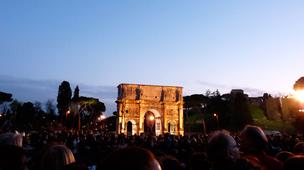 Each year, thousands of pilgrims flood St Peter’s Square before the evening Easter Vigil mass. The service, taking place the night before Easter Sunday, is the most important celebration of the liturgical year. The several-hour-long wait to enter St Peter’s Basilica, a requisite for anyone desiring a decent seat, tries the patience of the most devout Catholics — especially when even the nuns are pushing and shoving.
Each year, thousands of pilgrims flood St Peter’s Square before the evening Easter Vigil mass. The service, taking place the night before Easter Sunday, is the most important celebration of the liturgical year. The several-hour-long wait to enter St Peter’s Basilica, a requisite for anyone desiring a decent seat, tries the patience of the most devout Catholics — especially when even the nuns are pushing and shoving.
Related photo gallery: Christians celebrate Palm Sunday
But Holy Week, the Christian festival that commemorates the last week of Jesus' life, is a solemn celebration, and once mass begins, a calm settles over the congregation. As the pope makes his way through the cathedral, lit solely by candlelight, St Peter's no longer feels like a crowded tourist attraction. It becomes a place of worship.
Although Romans have had a love-hate relationship with all things papal since the Catholic Church began calling Rome its home since the 1st Century. To the faithful, St Peter - the disciple and first pope - started the official church in Rome at the conclusion of his journey after Christ's Ascension. Tradition holds that Peter was crucified in Rome, and St Peter's Basilica was erected over his tomb. The imperial city has been a prominent tourist destination since the early Middle Ages, with striking ruins, catacombs and holy sites.
Modern Holy Week is a pale shadow of celebrations of 500 years ago, said Thomas Cohen, a history professor at York University in Toronto. "It was a grand spectacle, with sermons and flagellants and great unveilings of holy objects," he said, "and there were processions galore, with music". But, with nearly 1.1 billion Roman Catholics in the world, the Eternal City continues to be a major pilgrimage site for Easter and the holy days leading up to it. With Rome's extensive history, religious celebrations and rich culture, spending the holiday in the ancient imperial city is an almost unrivalled experience.
Kicking off Holy Week is the lively and colourful celebration of Palm Sunday, when the grey St Peter's Square turns into a sea of green. Thousands of pilgrims wave palms and olive branches, symbols of peace, to be blessed by the pope as he leads a procession around the square before delivering mass outside.
On the night of Holy Thursday, the pope presides over the Mass of the Lord's Supper at the Basilica of St John Lateran, the official church of the pope located outside the Vatican walls. (Vatican City, an enclave within the city of Rome, has been the official seat of the Church since 1929.) The pope washes the feet of twelve priests, in remembrance of Christ washing the feet of his disciples. During the celebration this year, donations will be accepted for the victims of the earthquake and tsunami in Japan.
On Good Friday, the pope presides over the Way of the Cross - a celebration even non-Catholics can enjoy. Held in the evening, outside of the Coliseum, pilgrims huddle together, holding candles as clergymen make their way around the imperial amphitheatre and up to Palatine Hill, where the service concludes. The procession stops fourteen times recalling the scenes of Jesus' torture and crucifixion, known as the Passion of the Christ. This celebration dates back to the early Christians who walked the traditional route of Christ, from the believed location of Pontius Pilate's house to Calvary, the mountain where Jesus is believed to have died on a cross. (Tip: Because the Coliseum metro stop, Colosseo, is shut down for this event, take Metro line B to Circo Massimo and walk over to the Coliseum.)
Holy Week tourists too excited to sleep after Saturday night's Easter Vigil mass ends, at around 2 am, could stay up another five hours or so for more revelry the morning of Easter Sunday. While the week's earlier events commemorated Jesus' death, Easter mass commemorates what Catholics believe was his resurrection from death. Tickets are required for those who want a seat during mass, but St Peter's Square overflows with standing-room crowds of pilgrims hoping to catch a glimpse of the pope as he delivers the traditional blessing Urbi et Orbi, Latin for "to the City [Rome] and to the World".
After the week-long, at times draining, services of Holy Week, Rome is still up for a celebration. While some Romans retreat to the countryside on Easter, the city remains festive and crowded. Locals attend mass at their local parishes and spend the day relaxing with family and friends. But no Italian holiday is complete without an elaborate meal. During my visit in 2010, I went to the countryside south of Rome for a traditional Easter lunch with Italian family friends. Hours spent enjoying lamb, pasta, homemade wine and large Italian chocolate eggs, hollowed out with a prize inside was a perfectly local way to end a festive pilgrimage to Rome.
How to
Arrive to the celebrations well ahead of time to secure spots. Tickets are free to the major celebrations, including Holy Thursday, Easter Vigil and Easter Sunday, but you must reserve them months in advance. For tickets, contact your local diocese or The Prefecture of the Papal Household.



